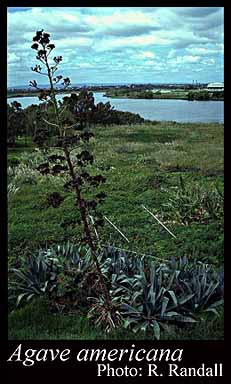- Reference
- Sp.Pl. [Linnaeus] 1:323 (1753)
- Conservation Code
- Not threatened
- Naturalised Status
- Alien to Western Australia
- Name Status
- Current
Rhizomatous, perennial tree-like monocot, to 6 m high, leaves fleshy, spine-tipped. Fl. yellow, Jan or Apr. Sand. Cultivated, occasionally naturalised around old habitations & along roadsides.

Distribution
- IBRA Regions
- Avon Wheatbelt, Carnarvon, Coolgardie, Dampierland, Esperance Plains, Geraldton Sandplains, Hampton, Jarrah Forest, Mallee, Murchison, Swan Coastal Plain, Yalgoo.
- IBRA Subregions
- Eastern Goldfield, Eastern Mallee, Eastern Murchison, Hampton, Lesueur Sandplain, Merredin, Northern Jarrah Forest, Perth, Pindanland, Recherche, Tallering, Wooramel.
- IMCRA Regions
- Abrolhos Islands, Leeuwin-Naturaliste.
- Local Government Areas (LGAs)
- Broome, Cockburn, Coorow, Dowerin, Dundas, Esperance, Fremantle, Gingin, Greater Geraldton, Irwin, Joondalup, Kalamunda, Kalgoorlie-Boulder, Leonora, Merredin, Nedlands, Perenjori, Perth, Rockingham, Shark Bay, Tammin, Victoria Plains.
Management Notes (for the Swan NRM Region)
Alternative Names. Maguey, American Aloe, American Agave, Wild Century-plant.
General Biology. Growth form. Herb. Life form. Perennial. Reproduction. Primarily seed, also suckers. Dispersal. Wind, water. Toxicity. Can be poisonous to mammals. Sap is irritant and can cause dermatitis.
Notes. Naturalised in Europe, southern Africa, New Zealand and Macaronesia. Can reduce native species diversity. Monocarpic (dies after fruiting), flowering only once after 10 to 15 years. Believed to be pollinated by bats and/or moths. Able to tolerate extremely high tissue temperatures. Reduces water loss by stomatal opening and CO2 uptake primarily occurring at night. Has higher vegetative establishment rates in sandy soils than clay soils. In its native habitat where sandy soils are rare there are low establishment rates, sandy soils outside its native range provide opportunities for rapid clonal reproduction. Although seed has high germination rates, most seedlings have been found to die shortly after germination. In other species of Agave water stress in the seedling stage may be the most important factor affecting establishment. Interspecies crosses with Agave tequilana can produce viable seeds.
Additional information. Origin. Mexico, south and central areas of the United States. History of use/introduction. Ornamental, medicines. Similar exotic species. Agave attenuata, A. sisalana.
Suggested method of management and control. Dig out and/or hand remove small infestations. Stem inject into base of leaves 1 part Tordon®/5 parts diesel. Read the manufacturers' labels and material safety data sheets before using herbicides. For further information consult the Australian Pesticides and Veterinary Medicines Authority to determine the status of permits for your situation or state.
Management Calendar
| Calendar Type | Jan | Feb | Mar | Apr | May | Jun | Jul | Aug | Sep | Oct | Nov | Dec | Comments |
|---|---|---|---|---|---|---|---|---|---|---|---|---|---|
| Active Growth | Y | Y | Y | ||||||||||
| Flowering | O | O | |||||||||||
| Fruiting | U | U | |||||||||||
| Manual Removal | Y | Y | Y | Y | Y | Y | Y | Y | Y | Y | Y | Y | |
| Herbicide Treatment | Y | O | O | O | O | O | O | O | O | O | Y | Y |
Legend: Y = Yes, regularly, O = Occasionally, U = Uncertain, referred by others but not confirmed.
References
- Anon. (2010) Agave americana L. Univeristy of Conneticut URL: http://florawww.eeb.uconn.edu/198800117.html - Accessed February 2010.
- Badano, E.I. & Pugnaire, F.I. (2004) Invasion of Agave species (Agavaceae) in south-east Spain: invader demographic parameters and impacts on native species. Diversity and Distributions, 10: 493-500.
- Bickerton, D.C. (2006) Using herbicide to control century plant (Agave americana): Implications for management. In 15th Australian Weeds Conference Proceedings: managing weeds in a changing climate, Edited by C. Preston, J.H. Watts and N.D. Crossman. Weed Management Society of SA Inc.
- Brown, K. & Brooks, K. (2002) Bushland Weeds: A Practical Guide to their Management. Environmental Weeds Action Network, Greenwood.
- Escobar-Guzman, R.E., Hernandez, F.Z., Vega, K.G. & Simpson, J. (2008) Seed production and gametopyhte formation in Agave tequilana and Agave americana. Canadian Journal of Botany, 86: 1343-1353.
- Howell, D.J. & Schropfer Roth, B. (1981) Sexual reproduction in Agaves: The benefits of bats: The cost of semelparous advertising. Ecology, 62 (1): 1-7.
- Hussey, B.M.J., Keighery, G.J., Dodd, J., Lloyd, S.G. & Cousens, R.D. (2007) Western Weeds. A guide to the weeds of Western Australia. 2nd Edition. The Plant Protection Society of Western Australia, Victoria Park.
- Jordan, P.W. & Nobel, P.S. (1979) Infrequent establishment of seedlings of Agave deserti (Agavaceae) in the northwest Sonoran Desert. American Journal of Botany, 66 (9): 1079-1084.
- Nobel, P.S. (1990) Environmental influences on CO2 uptake by agaves, cam plants with high productivities. Economic Botany, 44 (4): 488-502.
- Nobel, P.S. & Stanley, D.S. (2006) High and low temperature tolerances and their relationships to distribution of agaves. Plant, Cell & Environment, 6 (9): 711 - 719.
- Shepherd, R.C.H. (2004) Pretty but Poisonous. Plants Poisonous to People. An llustrated Guide for Australia. R.G. and F.J. Richardson, Melbourne.